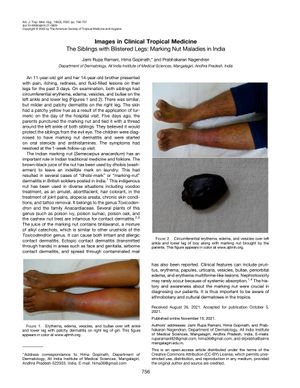The Siblings with Blistered Legs: Marking Nut Maladies in India
November 2021
in “
American Journal of Tropical Medicine and Hygiene
”

TLDR Marking nuts can cause skin irritation and allergies.
An 11-year-old girl and her 14-year-old brother in India developed dermatitis after their parents tied a marking nut (Semecarpus anacardium) around their ankles, believing it would protect them from the evil eye. The siblings experienced pain, itching, redness, and fluid-filled lesions, which resolved after treatment with oral steroids and antihistamines. The marking nut, used in traditional medicine and folklore, contains bhilawanol, which can cause irritant and allergic contact dermatitis. This case highlights the importance of understanding ethnobotany and cultural practices in diagnosing skin conditions in tropical regions.




